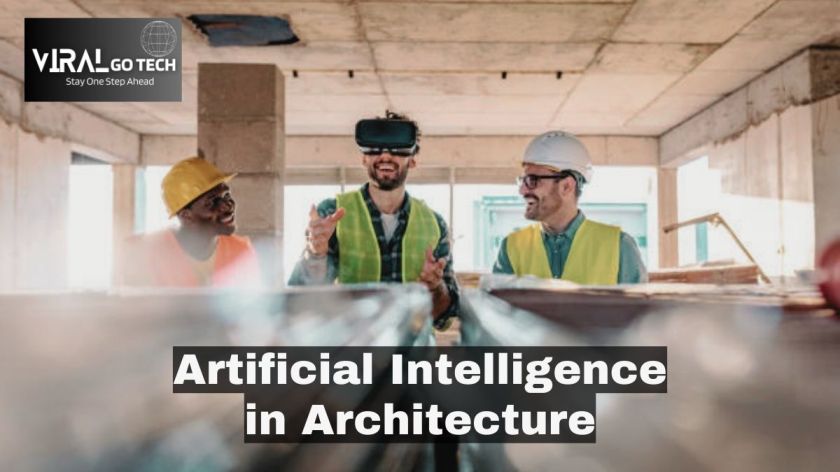Artificial Intelligence (AI) has emerged as a transformative technology across various industries, and architecture is no exception. As an architect, I have witnessed firsthand the impact that AI can have on the design process, from conception to construction. In this article, we will explore the fascinating world of Artificial Intelligence in architecture and delve into its benefits, challenges, and future implications.

Table of Contents
What is Artificial Intelligence?
It’s important to understand what artificial intelligence is in its most basic form before diving into its specialized applications in design. The development of computer systems with artificial intelligence (AI) can carry out activities that would ordinarily need human intelligence. These systems have the capacity to learn from data, spot trends, and take wise decisions. Artificial intelligence (AI) has the potential to completely change how we design and build buildings.
Introduction to Artificial Intelligence in Architecture
A world of previously unimaginable possibilities is now possible thanks to the integration of AI in architecture. Architects may improve productivity, boost creativity, and expedite the design process by utilizing AI technologies. Design choices may be generated, complex data sets can be analyzed, building performance can be simulated, and even everyday chores can be automated with the help of AI. As a result, architects may concentrate more on the creative aspects of their profession and produce outstanding designs that are specifically suited to the requirements of their clients.
The Benefits of AI in the Architectural Industry
AI has a wide range of advantages for the architecture sector. AI’s capacity to quickly digest large volumes of data is one of its main advantages. This makes it possible for architects to gather insightful information and make data-driven design choices. AI can also improve building performance by monitoring variables like energy use, daylighting, and thermal comfort. AI can be used by architects to design structures that are not only visually beautiful but also efficient and sustainable.
Additionally, AI-driven tools and technology can automate monotonous jobs like project management, drafting, and documentation. This decreases the possibility of errors while also saving time. AI can help architects generate design ideas based on particular criteria and restrictions, enabling them to consider a wider range of options. In general, AI equips architects to work more productively, make better choices, and complete projects that surpass customer expectations.

How AI is Transforming the Design Process
AI has the potential to transform every stage of the design process, from conceptualization to construction. At the initial stages, AI algorithms can generate design options based on input parameters such as site constraints, programmatic requirements, and user preferences. These algorithms can analyze existing architectural precedents, evaluate design patterns, and propose innovative solutions. This not only accelerates the design process but also stimulates creativity by providing architects with new perspectives and ideas.
As the design progresses, AI can assist in analyzing and optimizing building performance. By simulating factors such as lighting, airflow, and structural integrity, architects can identify potential issues and make informed design decisions. AI can also help architects in material selection, cost estimation, and construction planning, further streamlining the design process and reducing the likelihood of errors.
What role can AI play in Architecture Design?
AI can play a multifaceted role in architecture design, augmenting the capabilities of architects and pushing the boundaries of what is possible. Firstly, AI can act as a design assistant, providing architects with recommendations, generating design options, and assisting in the decision-making process. By analyzing vast amounts of data, AI algorithms can identify design patterns, extract insights, and propose innovative solutions that align with the project’s objectives.
Secondly, AI can serve as a design optimizer, helping architects fine-tune their designs to achieve optimal performance. By simulating and analyzing various design scenarios, AI algorithms can identify areas for improvement, such as energy efficiency, structural stability, and occupant comfort. This iterative optimization process ensures that the final design is not only visually appealing but also functional and sustainable.
Lastly, AI can act as a design collaborator, facilitating communication and collaboration between architects, engineers, and other stakeholders. By providing a shared platform for collaboration, AI technologies enable the seamless integration of different disciplines and ensure that all project stakeholders are on the same page. This reduces the likelihood of miscommunication, enhances coordination, and ultimately leads to better design outcomes.

AI-Driven Tools and Technologies for Architects
AI’s incorporation into architecture has led to the development of numerous tools and technologies that help improve the design process. A good example of one of these tools is generative design software, which creates a variety of design alternatives depending on predetermined objectives and limitations. This enables architects to investigate a variety of design options and find creative solutions that could not have been thought of otherwise.
Virtual reality (VR) is a different AI-driven technology that is gaining popularity in the architectural sector. A more intuitive and immersive experience can be had by architects and their clients by putting them both inside a virtual version of the design using virtual reality (VR). As a result, stakeholders can see the design in real-time, make wise choices, and offer comments early on. Additionally, VR enhances the overall design process by facilitating communication and cooperation between architects, clients, and other project stakeholders.
Case Studies: Successful Implementation of AI in Architecture
Several architectural firms have already embraced AI and reaped the benefits it offers. One notable example is the use of AI in designing energy-efficient buildings. By leveraging AI algorithms and simulation tools, architects can optimize building performance, reduce energy consumption, and minimize environmental impact. This not only benefits the environment but also helps clients save on operational costs in the long run.
Another case study involves the use of AI in parametric design. Parametric design is a design approach that uses algorithms to generate complex shapes and forms based on predefined parameters. By combining AI with parametric design software, architects can create intricate and innovative designs that are tailored to specific site conditions and user requirements. This allows for greater design flexibility, creativity, and customization.

Challenges and Limitations of AI in Architecture
While the potential of AI in architecture is immense, there are also several challenges and limitations that need to be addressed. One of the key challenges is the lack of data. AI algorithms rely heavily on data to learn and make informed decisions. However, architectural data is often fragmented, incomplete, or inaccessible, making it difficult for AI to perform optimally. Additionally, the quality of data can vary significantly, leading to biased or inaccurate results.
Another challenge is the ethical implications of AI in architecture. As AI becomes more integrated into the design process, questions arise regarding issues such as privacy, data security, and intellectual property rights. Architects need to navigate these ethical considerations and ensure that AI is used responsibly and in compliance with legal and ethical standards.
Furthermore, there is a concern that AI may replace human architects, leading to job losses and a loss of creativity. While AI can automate certain tasks and enhance efficiency, it cannot replicate the human intuition, creativity, and empathy that architects bring to the design process. Therefore, it is essential to view AI as a tool that augments the capabilities of architects rather than a replacement.
Ethical Considerations in AI-Driven Architecture
As AI continues to advance in the field of architecture, it is crucial to address the ethical considerations associated with its use. One of the key ethical considerations is privacy and data security. AI algorithms rely on vast amounts of data, including personal and sensitive information. Architects must ensure that this data is handled securely and that the privacy of individuals is protected.
Another ethical consideration is the potential bias in AI algorithms. AI algorithms are only as unbiased as the data they are trained on. If the training data is biased or reflects societal prejudices, the AI algorithms may inadvertently perpetuate these biases. Architects need to be mindful of this and ensure that the data used to train AI algorithms is diverse, representative, and free from biases.
Additionally, architects need to consider the impact of AI on social equity and inclusivity. AI algorithms have the potential to exacerbate existing social inequalities if they are not designed with inclusivity in mind. Architects must ensure that AI technologies are accessible to all and do not discriminate against any particular group.
The Future of AI in Architecture
AI in architecture has a bright future ahead of it, with new developments and opportunities. We may anticipate seeing increasingly advanced AI-driven tools that further improve the design process as AI technologies continue to advance. These tools will provide architects the ability to investigate intricate design options, enhance building efficiency, and produce ideas that are genuinely transformational.
Additionally, the way that buildings are designed, built, and operated will change as a result of the integration of AI with other cutting-edge technologies like the Internet of Things (IoT) and Building Information Modeling (BIM). Real-time data from IoT sensors installed in buildings may be analyzed by AI algorithms, enabling architects to track building performance, spot maintenance issues, and reduce energy usage.
7 Ways Artificial Intelligence Can Reshape Architecture
Automated Design Generation: AI algorithms can generate design options based on input parameters, accelerating the design process and stimulating creativity.
Building Performance Optimization: AI can analyze factors such as energy consumption and thermal comfort to optimize building performance and sustainability.
Virtual Reality Design Visualization: VR allows architects and clients to visualize designs in a virtual environment, facilitating better decision-making and communication.
Generative Design: AI-powered generative design software can generate multiple design options based on defined constraints, enabling architects to explore innovative solutions.
Parametric Design: AI algorithms can be combined with parametric design software to create complex shapes and forms based on predefined parameters, fostering design flexibility and customization.
Automation of Routine Tasks: AI-driven tools can automate repetitive tasks such as drafting and documentation, saving time and reducing the risk of errors.
Enhanced Collaboration: AI technologies provide a shared platform for collaboration between architects, engineers, and other stakeholders, enhancing coordination and communication.

Resources and Courses for Learning AI in Architecture
If you are interested in learning more about AI in architecture, there are several resources and courses available that can help you get started. Here are a few recommendations:
“Artificial Intelligence for Architects: Designing with Machine Intelligence” by Yaser Abu-Mostafa: This book provides an introduction to AI concepts and their application in architecture.
“AI in Architecture: Design Methods and Techniques” by Parveen Kumar: This book explores the various ways AI can be integrated into the architectural design process.
Online courses: Platforms such as Coursera and Udemy offer online courses on AI in architecture, covering topics such as generative design, parametric design, and VR visualization.
By investing time in learning about AI and its applications in architecture, you can stay ahead of the curve and leverage this transformative technology to enhance your design practice.
Conclusion
Artificial intelligence (AI) is transforming the world of architecture, providing architects with a plethora of tools and technology to improve the design process, optimize building performance, and create remarkable projects. Embracing AI allows architects to streamline their processes, tap into new worlds of creativity, and build an intelligent, sustainable, and user-centric built environment. To ensure the responsible and sustainable use of AI, it is necessary to negotiate the obstacles and ethical issues involved with it. We have the potential as architects to impact the future of architecture by leveraging the power of AI and creating a better future for humanity.

FAQs
Can AI replace human architects?
While AI can automate certain tasks and enhance efficiency, it cannot replicate the human intuition, creativity, and empathy that architects bring to the design process. Therefore, AI should be viewed as a tool that augments the capabilities of architects rather than a replacement.
How can AI enhance collaboration in architecture?
AI technologies give a common platform for architects, engineers, and other stakeholders to collaborate. AI improves cooperation and ensures that all project stakeholders are on the same page by promoting seamless communication, coordination, and integration of diverse disciplines.
What are the ethical considerations in AI-driven architecture?
Ethical considerations in AI-driven architecture include privacy and data security, bias in AI algorithms, and social equity and inclusivity. Architects must ensure that data is handled securely, AI algorithms are unbiased, and AI technologies are accessible to all without discrimination.
What is the future of AI in architecture?
With breakthroughs in AI-driven tools, integration with emerging technologies such as IoT and BIM, and the potential to create an intelligent, sustainable, and user-centric built environment, the future of AI in architecture looks bright. AI will continue to change the industry, pushing the frontiers of what architecture can achieve.
1 thought on “The Role of Artificial Intelligence in Architecture”